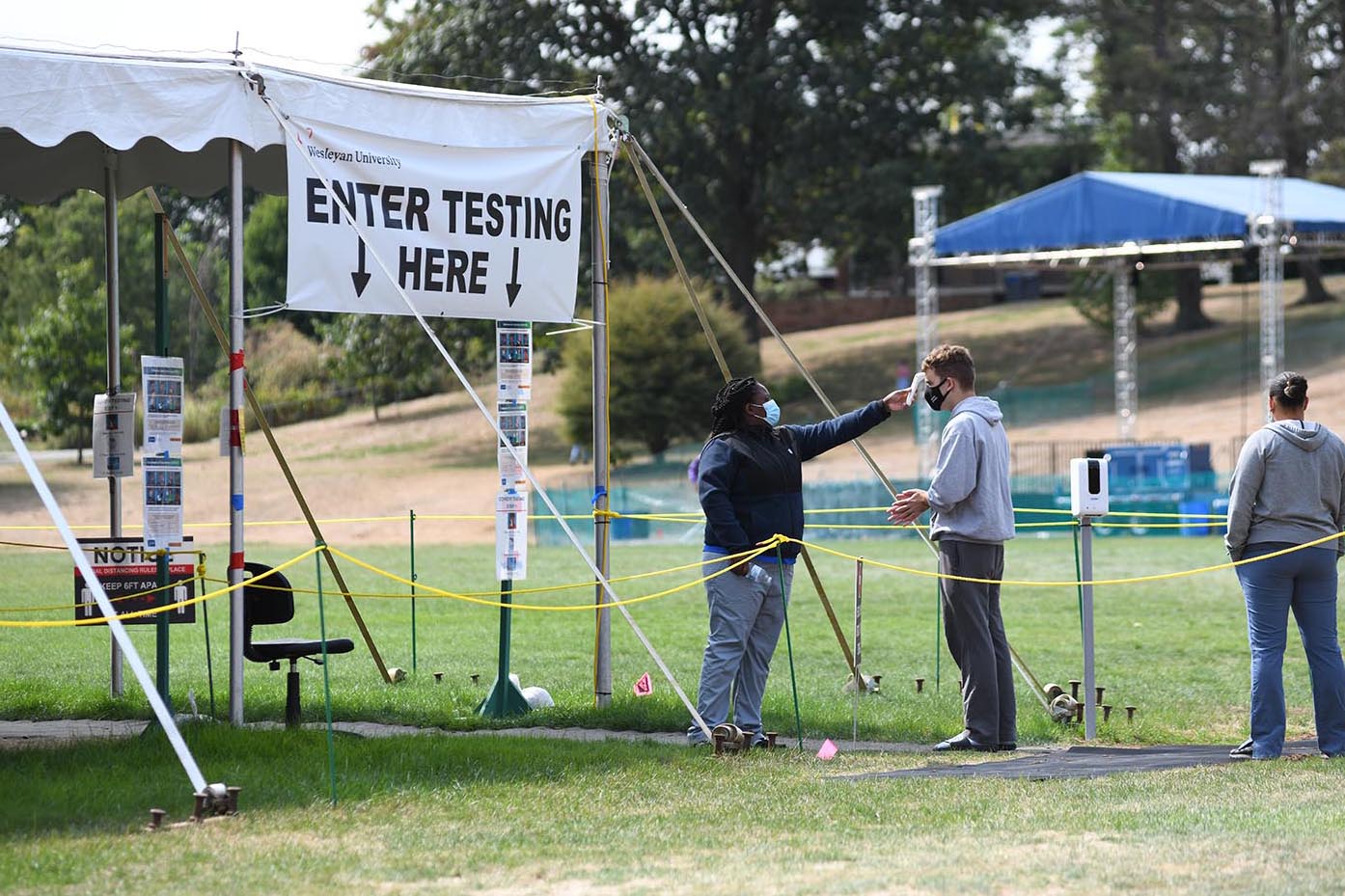Cooperation, Careful Planning Drive Successful Reactivation Efforts


Following a carefully coordinated return to campus and an initial period of remote learning during Connecticut’s mandated two-week quarantine, just two students and three employees at Wesleyan have tested positive for COVID-19 to date this fall. The low positivity rate, well under 0.1% of the entire campus population and tracked regularly on Wesleyan’s COVID-19 dashboard, reflects the care and planning that have gone into preparing the campus for the fall semester, as well as commendable adherence to safety protocols by the Wesleyan campus community. More than 15,000 tests have already been conducted.

“Our positivity rate on campus is lower than in Connecticut and we’re very pleased about that,” said Rick Culliton, associate vice president and dean of students, during a virtual All-Staff Convocation on Sept. 10. “We know that’s because of the hard work of our students, and of our testing to be able to isolate . . . watching all of the students wear masks, having physical distance between each other, and adhering to what we’re asking them to do has really been a very positive thing to see.”
Mike Whaley, vice president for student affairs, noted in a Sept. 6 message that the community’s care and diligence in following quarantine and safety protocols helped the University maintain positivity rates “well below the levels predicted by modeling.” This allowed Wesleyan to move forward into its first week of in-person classes, which saw the University maintain its low case count throughout the week. Wesleyan was recently among schools highlighted for “seemingly crack(ing) the code” in effectively navigating an in-person opening.
Culliton and President Michael Roth ’78 cited Wesleyan’s Reactivating Campus plan as a crucial part of these efforts, specifically the Community Agreement, which suggests that all members of the Wesleyan community “must act in a manner that demonstrates respect and consideration for the health and safety of others and are prohibited from creating a health or safety hazard.” Students, faculty, and staff must undergo regular COVID-19 testing, adhere to social distancing standards, and wear face coverings in classrooms and outside private spaces. They must exercise precautionary sanitization practices including regular hand washing, limiting gatherings on campus to a maximum of 25 individuals, suspending University-sponsored travel, and not permitting campus visitors. In addition, all students were required to participate in a 14-day quarantine upon arriving on campus.
Despite Wesleyan’s successful return to date, President Roth and other University administrators have continually stressed the need for the community’s continued vigilance, especially in light of the mercurial nature of the global pandemic.
“We’re getting great cooperation and we hope to continue to get it,” President Roth said during the University’s convocation. “It’s the kind of thing that you don’t want to celebrate the good news too enthusiastically because this virus, we all know, is one that is capricious, and could come back and disrupt things very quickly. So, we need to stay vigilant and we need to stay aware of one another and how our own actions can actually help the community or how those actions could actually create greater risks.”
According to a Sept. 13 Axios article, Wesleyan notably “stands out because it is committed to giving students opportunities to safely hang out with one another—unlike many campuses, which are desperately attempting to stop socialization.” The article cited President Roth’s Sept. 6 tweet, which stated, “In order to be safe enough spaces for learning, colleges must have access to rapid testing, basic contact tracing and provide guided, supportive isolation. We must also provide (masked) opportunities to socialize without large crowds.”
In response to the article, Middletown resident Brian Stewart, professor of physics, wrote to Wesleyan’s Community Forum on Sept. 14: “I continue to be impressed, and I have heard repeatedly from Wesleyan neighbors how impressed they are at the universal wearing of face coverings among students.” The article prompted Stewart to compile a list of COVID-19 best practices: Universal personal safety practices (face coverings, social distancing); frequent testing with short turnaround times; contact tracing and isolation of the sick and exposed; and “working with human proclivities instead of trying to thwart them.”
In a Sept. 14 public health reminder, Provost and Senior Vice President Nicole Stanton and Vice President for Student Affairs Mike Whaley thanked the campus community for its “continued creativity, perseverance and flexibility” and said that “those on campus have undoubtedly noticed that students are taking the safety precautions that we have outlined for them seriously. We expect to maintain a high degree of compliance as the semester continues.”
To date, more than 3,400 members of the campus community have been tested, and the University continues to require that students get tested twice per week, and employees at least once per week. Isolation spaces are currently at 0% occupancy.
The University has received isolated reports about students not wearing masks or sitting too close together, and one student was told to leave campus because of a violation during the quarantine period. University officials are reviewing and acting as necessary on these cases on an individual basis.
“If there are violations that put the public health at risk, we’re going to take the necessary steps to keep the campus safe,” Culliton said. “We’re working to address those issues as they come up.”
Although most students returned to campus prior to Labor Day, many faculty and staff have been working remotely, and are starting to repopulate academic offices this week.
“For those of us who are back on campus, I do feel like it’s been a safe environment for us to be in,” Culliton said. “People are really practicing what we’ve asked them to do. And I know over the course of the next month, as we look at folks who potentially have been remote, you have the ability to come back. We’re grateful for all of the campus’s cooperation and we hope that we’ll be able to continue that moving forward.”

